Subterranean Termites | Carpenter Ants | Pavement Ants | Citronella Ants | Yellowjackets | Wasps | Hornets | Carpenter Bees | Flies | Stink Bug | Bed Bug | Cockroaches | Cave Cricket | Fleas | Ticks | Spiders | Centipedes | Millipedes
Subterranean Termites
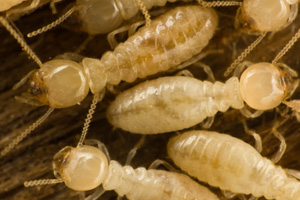 Termites are social insects which means there is a division of labor between different types of individuals or castes. Workers and nymphs of subterranean termites perform all the work of a colony. These two castes do all the damage to structures. Soldiers defend the colony against enemies and do not eat wood. Together, with the reproductives, they are fed by the workers. Both workers and soldiers are blind. Winged adults(often called swarmers) are primarily reproductives. Four different castes can develop from nymphs: workers, soldiers,winged (primary) reproductives, and supplementary reproductives.
Termites are social insects which means there is a division of labor between different types of individuals or castes. Workers and nymphs of subterranean termites perform all the work of a colony. These two castes do all the damage to structures. Soldiers defend the colony against enemies and do not eat wood. Together, with the reproductives, they are fed by the workers. Both workers and soldiers are blind. Winged adults(often called swarmers) are primarily reproductives. Four different castes can develop from nymphs: workers, soldiers,winged (primary) reproductives, and supplementary reproductives.
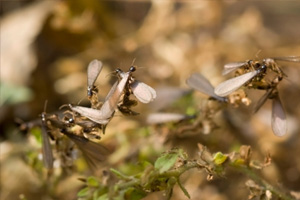 Primary reproductives (swarmer termites) are the caste most seen by homeowners. The winged adults are much darker than the other members of the colony. All four wings extend more than the length of the body and are of the same size in length. It usually requires twelve months of growth for swarmer termites to occur and only a few months for functional workers. Both female and male reproductives leave the colony in great numbers (swarms), usually in the Spring. Swarmers emerge on warm, sunny days when the humidity is high, often on days following rain showers.
Primary reproductives (swarmer termites) are the caste most seen by homeowners. The winged adults are much darker than the other members of the colony. All four wings extend more than the length of the body and are of the same size in length. It usually requires twelve months of growth for swarmer termites to occur and only a few months for functional workers. Both female and male reproductives leave the colony in great numbers (swarms), usually in the Spring. Swarmers emerge on warm, sunny days when the humidity is high, often on days following rain showers.
Moisture is critical to termite survival. Termites construct mud tubes when they pass over exposed areas. These termite tubes: conceal the termites, provide the termites with a moist environment, and protect them from their enemies (especially ants.)
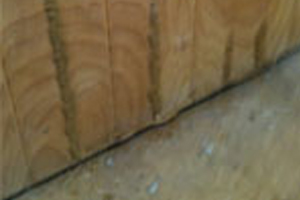 The most distinctive feature of a subterranean termite damage is the presence of a brown mud -like material which lines the galleries in an irregular pattern. They will travel from their nests in the ground to the wood, or other cellulose-bearing material upon which they feed. They will only make trips inside wood or in the mud tubes they construct.
The most distinctive feature of a subterranean termite damage is the presence of a brown mud -like material which lines the galleries in an irregular pattern. They will travel from their nests in the ground to the wood, or other cellulose-bearing material upon which they feed. They will only make trips inside wood or in the mud tubes they construct.
Homeowners Insurance does not cover termite damage. Subterranean termites can do major damage to a home or building if not treated properly.
Carpenter Ants
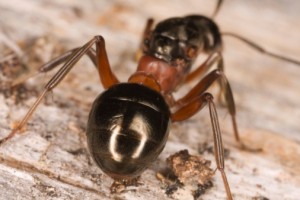 These are the most conspicuous of ants found in and around homes. They are large and typically blackish or very dark-bodied. Many species are black with some faintly grayish bands on the abdomen. Workers vary greatly in size, from 1/4 to about 3/4 inch long.
These are the most conspicuous of ants found in and around homes. They are large and typically blackish or very dark-bodied. Many species are black with some faintly grayish bands on the abdomen. Workers vary greatly in size, from 1/4 to about 3/4 inch long.
These ants excavate galleries of wood which somewhat resemble the work of termites. They are distinguished by their clean, smooth and sandpapered appearance of their galleries. The galleries are hollowed in moist or unsound wood, although carpenter ants can also borrow in sound wood. They do not use wood for food , but hollow it out for nesting.
Outdoor nesting sites include stumps, hollow logs, telephone poles, fence posts, or similar pieces of wood that is moist or partially decayed. Indoor nesting sites may be found in hollow doors, substructure of porches, window sills, behind baseboards, roofs, shingles, fireplaces, or other natural hollow areas.
Winged reproductive forms swarm primarily in the Spring. They may also do so at other times of the year. In a mature colony, 200 to 400 winged individuals are produced each year. At least 2000 to 3000 more workers and battle intruders that explore and forage for food may be present. Foraging ants will travel 100 yards or more from the nest for food which may consist of honeydew, sweets and meats found in kitchens, syrup, honey, sugar, jelly, grease and fat.
Carpenter Ants damage structures, contaminate food, and are unsightly and unwanted inside and outside of buildings or homes. Their nesting activities can weaken building structures and cause serious damage.
Pavement Ants
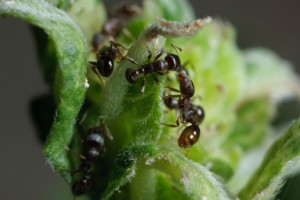 These ants are small 1/8 to 1/16 inch long blackish-brown ant with paler legs and antennae. The abdomen is all black. Nests re usually found outdoors under stones, under cracks of pavement, or next to buildings. They are occasionally found in walls, in insulation and under floors. Homes with slab on grade construction attract these ants and they become a nuisance for these homes. Foragers enter buildings through cracks in the slab and similar openings. Slow in movement, these ants enter buildings or homes in search of food, with sweet and greasy materials being preferred.
These ants are small 1/8 to 1/16 inch long blackish-brown ant with paler legs and antennae. The abdomen is all black. Nests re usually found outdoors under stones, under cracks of pavement, or next to buildings. They are occasionally found in walls, in insulation and under floors. Homes with slab on grade construction attract these ants and they become a nuisance for these homes. Foragers enter buildings through cracks in the slab and similar openings. Slow in movement, these ants enter buildings or homes in search of food, with sweet and greasy materials being preferred.
Citronella Ants
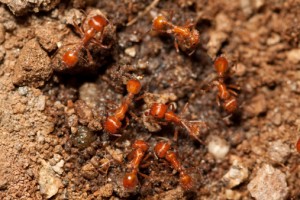 Also known as the Large Yellow Ant, it is named “citronella” because of the citronella-like odor given off when the ant is crushed. Workers are reddish-brown color and 1/5 inch long. Winged reproductive ants swarm in early Spring around house foundations and in basements. They are frequently mistaken for termites. Outdoor nests are found stumps, old logs, and under stones. Outdoors or indoors, this ant brings large piles of dirt to the surface of the ground at the entrance of its nest. Aside from the debris the citronella ant creates, no harm is done to the home or building it nests near.
Also known as the Large Yellow Ant, it is named “citronella” because of the citronella-like odor given off when the ant is crushed. Workers are reddish-brown color and 1/5 inch long. Winged reproductive ants swarm in early Spring around house foundations and in basements. They are frequently mistaken for termites. Outdoor nests are found stumps, old logs, and under stones. Outdoors or indoors, this ant brings large piles of dirt to the surface of the ground at the entrance of its nest. Aside from the debris the citronella ant creates, no harm is done to the home or building it nests near.
Yellowjackets
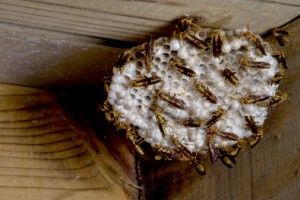 Yellow Jackets are the smallest of the common Vespids about 1/2 inch long. Most species build their nests underground. Workers will come and go via an earthen tunnel which ends in a hole at the soil surface. Underground nests are usually started in an underground cavity or abandoned mammal burrow. The nest is expanded to fill the cavity first and then enlarged as the colony develops. Yellowjackets will utilize openings that are available at or near ground level. They have been known to build extensive nests within voids of concrete block foundation, or below railroad ties used in landscaping. Nests can be also built under outdoor childrens’ play yards and underneath decking. Yellowjacket nests resemble hornet nests. As many as several thousand workers may be produced in a colony in one season.
Yellow Jackets are the smallest of the common Vespids about 1/2 inch long. Most species build their nests underground. Workers will come and go via an earthen tunnel which ends in a hole at the soil surface. Underground nests are usually started in an underground cavity or abandoned mammal burrow. The nest is expanded to fill the cavity first and then enlarged as the colony develops. Yellowjackets will utilize openings that are available at or near ground level. They have been known to build extensive nests within voids of concrete block foundation, or below railroad ties used in landscaping. Nests can be also built under outdoor childrens’ play yards and underneath decking. Yellowjacket nests resemble hornet nests. As many as several thousand workers may be produced in a colony in one season.
Yellowjackets are stinging insects, although most serious stinging incidents occur when the nest is accidentally disturbed. Humans are usually ignored by the yellowjacket worker away from its nest. Single stings usually happen when a worker is accidentally trapped against some part of the human body such as between folds of clothing, under the arm or leg, or in the mouth, swallowing a beverage. Many experts consider yellowjackets to be most dangerous because of their foraging and nesting behavior, and the prevalence of allergic people.
Wasps
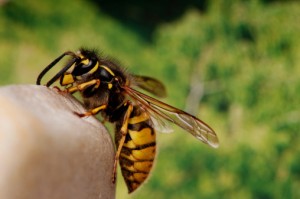 Wasps are considering some of the most dangerous species of stinging Vespidae. A useful characteristic in the field is that they fold their wings lengthwise when at rest. This makes their wings seem only half as wide as they actually are. Wasps are social insects. They build their nests of a paper-like material, called carton. Carton is a mixture of wood fibers and the salivary secretions of the female wasps. New colonies are founded each year because queens are inactive over winter hiding in protective bark, or in stone walls, attics, or other sheltered places. In early Spring, nests are found by the foundresses, (queens) as she builds a small number of cells and places an egg in each. After the first sterile female workers emerge, these workers take over the nest, and brood rearing. Only one adult egg-producing queen will be present in the colony and nest. Workers protect and maintain the nest forage for food and water and care for the immature stages of brood.( eggs, larvae, and pupae.)
Wasps are considering some of the most dangerous species of stinging Vespidae. A useful characteristic in the field is that they fold their wings lengthwise when at rest. This makes their wings seem only half as wide as they actually are. Wasps are social insects. They build their nests of a paper-like material, called carton. Carton is a mixture of wood fibers and the salivary secretions of the female wasps. New colonies are founded each year because queens are inactive over winter hiding in protective bark, or in stone walls, attics, or other sheltered places. In early Spring, nests are found by the foundresses, (queens) as she builds a small number of cells and places an egg in each. After the first sterile female workers emerge, these workers take over the nest, and brood rearing. Only one adult egg-producing queen will be present in the colony and nest. Workers protect and maintain the nest forage for food and water and care for the immature stages of brood.( eggs, larvae, and pupae.)
Paper wasps build comb nests which open downward and are not covered. These nests are usually suspended beneath horizontal surfaces and hang from eaves of houses and beneath window ledges, or porch roofs.
Hornets
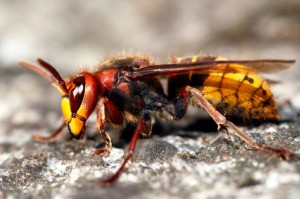 Hornets nests are the most universally recognized and fear-provoking social wasp nests. They are large grayish-brown carton structures often seen hanging from a bush or tree. They resemble a very large , inverted tear drop or a “bloated” soccer ball. The nest consists of several tiers of carton cells and a continuous paper envelope surrounds the whole nest. Their is a single opening at the lower tip of the nest.
Hornets nests are the most universally recognized and fear-provoking social wasp nests. They are large grayish-brown carton structures often seen hanging from a bush or tree. They resemble a very large , inverted tear drop or a “bloated” soccer ball. The nest consists of several tiers of carton cells and a continuous paper envelope surrounds the whole nest. Their is a single opening at the lower tip of the nest.
The Bald-Faced hornet is large and has a whitish or yellowish markings on the front of the head, between the eyes. The basic color of the body is black. The European hornet is the largest paper wasp and the only true hornet present in the United States. Its body is brownish and marked with orange. This hornet does not build exposed nests but nests in natural cavities such as hollow logs, or stumps, or cavities in buildings.
Carpenter Bees
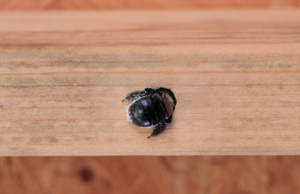 Carpenter bees resemble large bumblebees although they have very different nesting behavior. These bees bore long tunnels into wood. The tunnels are then divided into cells where individual larvae will develop. The carpenter bee is black in color and marked with areas of yellow hair. The dorsal side of its abdomen segments have no areas of yellow hair.
Carpenter bees resemble large bumblebees although they have very different nesting behavior. These bees bore long tunnels into wood. The tunnels are then divided into cells where individual larvae will develop. The carpenter bee is black in color and marked with areas of yellow hair. The dorsal side of its abdomen segments have no areas of yellow hair.
The carpenter bee gallery has an entrance hole on the wood surface. The gallery continues inward for a short distance and then turns upward and runs in the same direction as the grain of wood. The female then inserts balls of pollen into the cells of the gallery upon which the eggs are laid. She then closes the cell with wood pulp and works backward out of the gallery. Carpenter bee nests ar not hard to locate. Some of the most common sites chosen in buildings include wooden shakes, porch ceilings, decking, siding, eaves, windowsills, doors, etc. Adult bees emerge in late summer and then return to the same tunnels to hibernate for the winter months. The adults mate and lay eggs in the spring, completing the cycle.
Flies
Flies of many kinds have affected man and his welfare for many years. Some flies suck blood, others are scavengers, many transit disease organisms, some live at the expense of other insects and some aid in the pollination of plants.
 The common house fly is 1/4 inch long, dull gray with four stripes on its thorax and the fourth wing vein sharply angled. It prefers animal waste, human excrement, garbage, ground contamination , and other decaying organic matter as its host material. House flies have mouthparts which enable them to ingest only liquid materials. Solid foods materials are liquefied by regurgitated saliva. The common house fly is most abundant later summer and early fall.
The common house fly is 1/4 inch long, dull gray with four stripes on its thorax and the fourth wing vein sharply angled. It prefers animal waste, human excrement, garbage, ground contamination , and other decaying organic matter as its host material. House flies have mouthparts which enable them to ingest only liquid materials. Solid foods materials are liquefied by regurgitated saliva. The common house fly is most abundant later summer and early fall.
 Bottle flies are common in populated areas near slaughterhouses, meat-processing plants and garbage cans in urban areas. Single garbage cans have been known to produce more than 30,000 flies in one week. Adults are usually large flies with a metallic blue, bronze or green color. They are common in homes and other buildings in cool weather if suitable breeding materials are present. They are attracted to dead animals, meat and decaying vegetable matter.
Bottle flies are common in populated areas near slaughterhouses, meat-processing plants and garbage cans in urban areas. Single garbage cans have been known to produce more than 30,000 flies in one week. Adults are usually large flies with a metallic blue, bronze or green color. They are common in homes and other buildings in cool weather if suitable breeding materials are present. They are attracted to dead animals, meat and decaying vegetable matter.
Phorid Flies are also known as humpbacked flies superficially resemble fruit flies. They prefer decaying vegetation and animal matter. They are most abundant in warmer months and can be found breeding wherever moisture exists. These areas can include plumbing and drains in bathroom and kitchen areas, garbage containers, crawl space areas and basements. Adults can be found flying in most areas of the house and can be active even through the winter months.
 Fruit Flies, also called pomace flies, are about 1/8 inch long, yellowish brown with red eyes. They hover around ripe or decaying fruits, empty bottles or cans, drains and garbage disposals, and around areas of moisture including cleaning rags and mops. They prefer garbage, decaying fruits, and vegetables as their host materials. Fruit flies are of concern both as nuisance pests and contaminators of food. Eggs are laid near the surface of fermenting materials, such as dirty garbage containers, rotten vegetables, fruit or slime in drains. The adult female lays 500 eggs which mature in 9 to 12 days. A very large number of them can appear in a short time time. Fruit flies are most abundant in late summer and early fall.
Fruit Flies, also called pomace flies, are about 1/8 inch long, yellowish brown with red eyes. They hover around ripe or decaying fruits, empty bottles or cans, drains and garbage disposals, and around areas of moisture including cleaning rags and mops. They prefer garbage, decaying fruits, and vegetables as their host materials. Fruit flies are of concern both as nuisance pests and contaminators of food. Eggs are laid near the surface of fermenting materials, such as dirty garbage containers, rotten vegetables, fruit or slime in drains. The adult female lays 500 eggs which mature in 9 to 12 days. A very large number of them can appear in a short time time. Fruit flies are most abundant in late summer and early fall.
Stink Bug
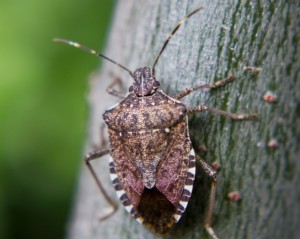 The Brown Marmorated Stink bug also known as the Shield Bug have emerged as a major pest. Asia origin, this bug was introduced in Allentown, Pennsylvania between 1996 and 1999 as a entomological study . These pests feed on a wide variety of fruits, seeds and berries produced by trees and ornamental plants. The get their name from the odor emitted from their scent glands when disturbed or crushed. In recent years they have become a major pest problem of homes and buildings. They enter structures in the fall and appear indoors until they exit the following summer looking for food. Over the winter months they will survive by populating an artificially heated, structure such as your home or office building.
The Brown Marmorated Stink bug also known as the Shield Bug have emerged as a major pest. Asia origin, this bug was introduced in Allentown, Pennsylvania between 1996 and 1999 as a entomological study . These pests feed on a wide variety of fruits, seeds and berries produced by trees and ornamental plants. The get their name from the odor emitted from their scent glands when disturbed or crushed. In recent years they have become a major pest problem of homes and buildings. They enter structures in the fall and appear indoors until they exit the following summer looking for food. Over the winter months they will survive by populating an artificially heated, structure such as your home or office building.
Stink bugs enter structures to survive the cold winter months. They seek warmth found within the insulated walls of a building. Possible entry points on a structure include gaps around windows, doors, vents, chimneys, eves, unfinished or improperly finished siding, and gaps in sliding glass doors. Stink bugs had the ability to slip into cracks and voids that we cannot see. During the Fall , they can be very active in the home as they settle down for the winter months. Activity may continue through the cold winter months as the sun or heating system warms walls. This allows them to remain dormant and undisturbed through cold weather. They then reanimate when the weather outside allows them to find food. Activity can peak again in the warmer months of April, May, and June. During these months they return outside to feed on fruit producing plants. Stink bugs do not reproduce indoors. They simply use wall voids of a home or structure as a nesting place to keep warm from the cold winter temperatures.
The diet of a stink bug includes saps and nectars from flowers and trees as well as fruits and seeds. They are generally inedible and not attracted to most mammals because of the odor they secrete when threatened or crushed. Due this fact, the explosion of the Stink bug has increased tremendously over the years.
Stink bugs are active in structures much longer than any other over-wintering pests. Indoor activity of these pests appear to revolve around the availability of their food source, and entering structures earlier and exiting structures later then other over-wintering pests. The activity in structures can occur from early September until mid June.
Solutions to a Stink bug problem starts with an interior and exterior inspection of a home or building to reduce or eliminate possible entry points. This includes caulking any gaps around windows, doors, sliding doors, vents, eves, and screened louvered attic or soffit vents with window screening. Replacing dry cracked or faulty gaskets around windows and garage doors and replacing punctured screens can also reduce entry. Glue boards can also be placed in strategic locations in the interior of a structure to collect these bugs that have already entered the home or building.
Additionally, three exterior chemical applications in the Spring, Summer and especially in the Fall will typically reduce populations of stink bugs 90-100%. Treatments made the last two weeks of August and the first two weeks of September is crucial. Percent reduction will begin to decline for treatments that are made later in the fall. It is entirely possible and even probable that you will occur additional problems as time goes on because of the resilient nature of this pest, as well as the massive populations that they create in a relatively short time.
Bed Bug
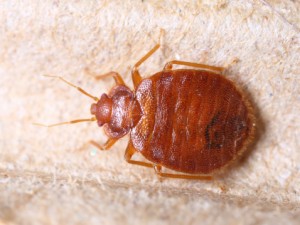
The Bed bug are universal pests of man and animals, as well as bats, birds and various other animals. The sole food of bed bugs is the blood of warm-blooded animals. Common names of these pests include “mahogany flat”, “chinch” and “red coat”.
The adult bed bug is 1/5 inches long and 1/8 wide. Its reddish-brown mahogany colored body is oval-shaped and flattened. Its body becomes considerably larger, longer and less flattened after feeding. Although the bed bug is covered by tiny hairs, they are almost invisible to the naked eye and its general body appearance is shinny. They have piercing-sucking mouthparts which allow them to pierce the skin and suck blood from their hosts.
Bed bug egg are elongated and usually attach to a surface when laid. The eggs are not found on the hosts body, but found on surfaces nearby to where the hosts sleeps or nests. The female bed bug lay about two eggs per day until she has laid approximately two-hundred eggs.
Bed bugs are very hardy insects. Adults and nymphs can survive prolonged periods of adverse temperatures conditions or without food or water. Adults can survive over winter in a unheated building and live for a year or longer without feeding.
Humans are preferred hosts for the common bed bug. They will also feed on animals such as poultry, mice, rats, canaries, dogs, and cats when necessary. Normally, the bed bugs will feed at night. They will also feed during daylight hours in such places as rest rooms, theaters, offices.
Bed bugs hide in cracks and crevices during normal daylight hours. They easily enter these areas because of their extremely flat bodies. Hiding areas include folds and tufts of mattresses, coils of springs, upholstery chairs and sofas, cracks and hollow posts of bedsteads. They are not restricted to these areas. In heavy infestation, they can be found behind loose wallpaper, behind pictures on the wall, under door and window casings, behinds baseboards, in light fixtures and medicine cabinets. They can also be found under carpeting, in folds of draperies, behind electrical switch plates, in unused ovens or broilers, and in motor compartments of electric refrigerators. Bed bugs give off a distinct odor from glands on their thorax. Their bites cause welts and irritation to people. Fecal spots and bloody spots left on sheets and pillowcases when bed bugs are engorged and crushed are a true sign of infestation.
Bed Bug Preparation Procedures
It is usually desirable to apply treatment for bed bugs early in the day . Residues need several hours to dry or dusts will have time to settle before the room can be used for sleeping or occupancy. It is particularly important to dry and cover mattresses completely before they are re-used, as a safety consideration. Hennebry Pest will complete prep work at an additional cost ahead of any treatment administered. The following steps are crucial in the management and treatment of bed bugs.
- Bed sheets, mattress covers, and pillow cases must be removed and washed in hot water.
- Mattress must be removed from bed frame and box spring.
- Night stands, dressers and closets must be empty prior to treatment.
- All personal items must be removed from treatment areas.
- Head boards must be removed if secured to wall.
- Light switch and receptacle covers must be removed.
- When box springs are infected, it is recommended they be discarded and replaced with new. If not replaced, mattress must be placed in a bed bag which we can provide.
- No pets or persons should be present during treatments. A minimum of four (4) hours must be allowed before re-entry into treated areas.
- Do not transfer any contents from an infested room to an untreated area.
- It is recommended that all adjacent rooms be treated in conjunction with the infested room. This will provide optimum results in controlling bed bugs. This will also allow a “service agreement” to be placed on the treated areas.
- We do not remove any items or place them back in their respective space.
- All wall hangings must be removed from walls and left in room for treatment.
- A minimum of THREE (3) follow-up treatments is required 7 to 10 days apart due to the nature of this pest.
Cockroaches
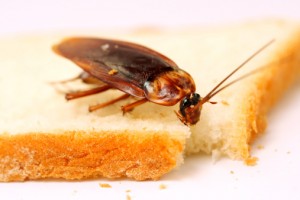 Cockroaches are one of the most adaptable and successful insect groups. There are over 3500 species worldwide and about 60 species found in the United States. The German Cockroach are the most commonly encountered. They produce odorous secretions from various points in their bodies which can affect the flavor of foods. Disease-producing organisms such as bacteria that cause food poisoning , dysentery, and diarrhea are carrying by cockroaches on their legs and bodies. The bacteria is then deposited on food and untensils as they forage. Cockroach excrement and cast skins also contain allergens, to which many people exhibit allergic responses such as skin rashes, watery eyes, and sneezing.
Cockroaches are one of the most adaptable and successful insect groups. There are over 3500 species worldwide and about 60 species found in the United States. The German Cockroach are the most commonly encountered. They produce odorous secretions from various points in their bodies which can affect the flavor of foods. Disease-producing organisms such as bacteria that cause food poisoning , dysentery, and diarrhea are carrying by cockroaches on their legs and bodies. The bacteria is then deposited on food and untensils as they forage. Cockroach excrement and cast skins also contain allergens, to which many people exhibit allergic responses such as skin rashes, watery eyes, and sneezing.
Cockroaches are most active at night where they forage for food, water, and mates. They prefer a moist environment and high degree of warmth. They are scavengers and feed on starches, sweets, grease, meat products, cheese, beer, leather ,bakery products, glue, hair, dried skin flakes, and dead animal and plant material. Cockroaches are also particularly attracted to fermented foods and beverages (beer spills). They live in cracks and crevices which their oval flat- bodies enable them to squeeze into. Cockroaches are well known for moving to new areas via “hitchhiking”.
Adults are pale to medium-brown and 1/2 – 5/8″ long. Females usually produce 4 – 8 egg capsules in her lifetime which contain 30-48 eggs. The German Cockroach has a larger number of eggs per capsule then any other species. They also have the shortest period to develop from hatching until sexual maturity and have a “high reproductive potential”. Roaches are regularly carried from place to place in such things as bagged potatoes and onions, beverage cartons, grocery bags, food carts, handbags, and folds of clothing. It is important to determine how cockroaches are transported into any premise in order to successfully treat the infestation.
The presence of cockroaches is detected by their damage, or by their fecal matter called “frass” they deposit. Their filth from their habit of feeding and harborage in damp and unsanitary places is spread to food supplies, food preparation surfaces, dishes and utensils. Far more food is contaminated by cockroaches than they are able to eat.
The first aspect of treatment is sanitation which helps to eliminate food, moisture, and harborage. A pest management program which includes inspection and survey, treatment, client education, and follow-up is crucial in the treatment of this stubborn pest.
Cave Cricket
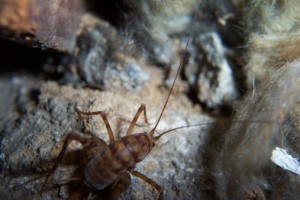 The cave cricket are pests indoors especially in damp and dark basements. In numbers, they can cause damage to linens, rayon and furs. They will attack paper, all foods and rubber. Adults are 3/4 inch long with three dark bands on the head and long thin antennae. Their body is light yellowish-brown. Crickets are active at night and usually remain hidden during the day. They are omnivorous, eating and drinking almost anything that is available. Control of crickets involves treatment both inside and outside a structure, removal of breeding and feeding sites outdoors, and the use of tight fitting screens and doors.
The cave cricket are pests indoors especially in damp and dark basements. In numbers, they can cause damage to linens, rayon and furs. They will attack paper, all foods and rubber. Adults are 3/4 inch long with three dark bands on the head and long thin antennae. Their body is light yellowish-brown. Crickets are active at night and usually remain hidden during the day. They are omnivorous, eating and drinking almost anything that is available. Control of crickets involves treatment both inside and outside a structure, removal of breeding and feeding sites outdoors, and the use of tight fitting screens and doors.
Fleas
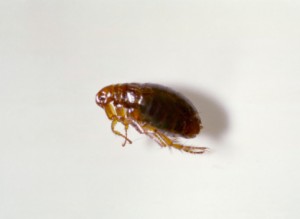 Fleas are pests of human and their domestic animals all over the world. Most fleas prefer non-human hosts, although, many do feed readily on humans when infestations are heavy or other hosts are not available.
Fleas are pests of human and their domestic animals all over the world. Most fleas prefer non-human hosts, although, many do feed readily on humans when infestations are heavy or other hosts are not available.
Fleas are small , wingless, insects, 1/12 to 1/6 inch long but can vary to as long as 1/3 inch long. The fleas body is narrow from side to side which allows them to move readily between hairs of their hosts. They have piercing sucking mouthparts to penetrate the skin of their host and suck blood. Their powerful legs permit them to jump as much as 7 – 8 inches vertically and 14-16 inches horizontally.
A female will lay a few eggs each day until she has laid up to 200-400 eggs in total. Flea larvae are small, active , maggot like creatures which are rarely seen in the field by homeowners. They become entwined with in carpets and resist the pull of a vacuum. Flea problem seem to peak in the Spring, summer and fall seasons when environmental conditions are common indoors and out. They are carriers of parasites or disease organisms and can transmit plague or typhus.
Customers calling about fleas will see small dark insects that jump. These insects may be biting people and they may be a dog or cat present in the home or apartment. Flea bites on humans is a formation of a small, hard, red, slightly raised itching spot, with a pale, flesh colored center. Bleeding may occur.
Consistent and effective flea management in and around homes requires a carefully organized and executed pest program. This can mean up to several flea treatments of the pet(s) and the restriction of the pet’s access to other flea-infested pets or landscape areas in the yard and neighborhood. Inspections, interview with the client, education and indoor and outdoor treatments are necessary in pest management of these tiny-biting insects.
Ticks
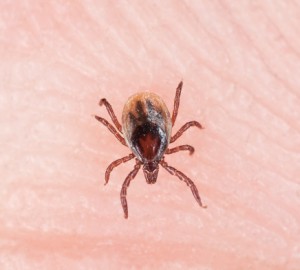 Ticks are the largest and most conspicuous member of the order Acarina and feed exclusively on the blood of vertebrates. Their are two families of ticks, hard ticks, and soft ticks. When a female becomes engorged with blood, her abdomen increases to many times its normal dimensions. Males do not become so large when engorged.
Ticks are the largest and most conspicuous member of the order Acarina and feed exclusively on the blood of vertebrates. Their are two families of ticks, hard ticks, and soft ticks. When a female becomes engorged with blood, her abdomen increases to many times its normal dimensions. Males do not become so large when engorged.
Most ticks spend the bulk of their life on or near the ground waiting for a suitable host . They cannot hop, run, fly, or move quickly. Ticks must climb onto an appropriate object such as tall grass, weeds, or fences and wait for a host to pass by. After they detect vibrations or host odors, they will fall from their perch and snag or attach onto a passing host. Most ticks will feed on blood from a wide variety of animals. Paralytic symptoms disappear rapidly upon removal of the tick.
Lyme disease is caused by a bacteria called spirochete and is a disease organism vectored principally by the hard tick. This tick commonly attacks white-tailed deer. Symptoms of Lyme-disease can be severe including acute headache, serious nervous system impairment, rheumatoid arthritis, red rash near the tick bite, fever, abdominal and joint pain, dizziness, and stiff neck. It is important for tick management and treatment to deter the spread of this disease to humans and their counter pets.
Spiders
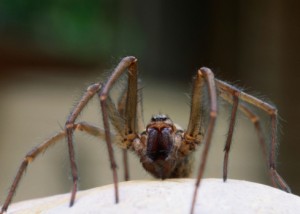 Many species of spiders are common household pests which spin webs over lamps, in corners and in basements. This may create an unsightly situation but cause no real harm. Many spiders are associated with moisture. They are found in crawl spaces, basements and other damp parts of buildings and homes. Others live in warm, dry places and are found in subfloor air-vents, in attics, and in upper corners of rooms. Most species hide in darkened areas, cracks, and other retreats which they construct out of silk.
Many species of spiders are common household pests which spin webs over lamps, in corners and in basements. This may create an unsightly situation but cause no real harm. Many spiders are associated with moisture. They are found in crawl spaces, basements and other damp parts of buildings and homes. Others live in warm, dry places and are found in subfloor air-vents, in attics, and in upper corners of rooms. Most species hide in darkened areas, cracks, and other retreats which they construct out of silk.
Control of spiders indoors involves nothing more than vacuuming up the spiders, their egg sacs and webs. Removal of clutter will also help reduce spider problems. Treatment is needed if breeding occurs indoors or if outdoor species are migrating indoors. Eliminating spiders on porches, under eaves, and other areas on the outside of buildings or homes near lakes is crucial in reducing spider populations. Spiders will spin webs, catch and feed on flying insects which come out of the lake. Spider fecal droppings can disfigure fiberglass boats or latex painted surfaces of buildings or homes.
Centipedes
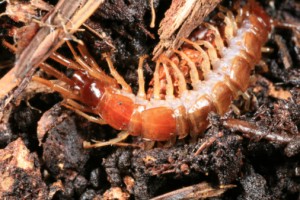 The house centipede is a common pest which generally lives its entire life inside a building. The body of this centipede is usually only 1 to 1 1/2 inches long. It has 15 pairs of very long legs which make it seem much larger. The body is grayish -yellow with three dark stripes extending the full length of the back. Their legs are long in proportion to the body size and have alternate light and dark bands running around them. The house centipede prefers to live in damp areas such as closets, cellars, bathrooms, attics, (during warmer months) and unexcavated areas under the home. Eggs are laid in these damp areas and in baseboards, or beneath bark in firewood. The house centipede forages at night for small insects and their larvae, and for spiders. Control is a simple operation with treatment applied to all usual hiding places such as crawl spaces, dark corners in attics and basements and behind baseboards.
The house centipede is a common pest which generally lives its entire life inside a building. The body of this centipede is usually only 1 to 1 1/2 inches long. It has 15 pairs of very long legs which make it seem much larger. The body is grayish -yellow with three dark stripes extending the full length of the back. Their legs are long in proportion to the body size and have alternate light and dark bands running around them. The house centipede prefers to live in damp areas such as closets, cellars, bathrooms, attics, (during warmer months) and unexcavated areas under the home. Eggs are laid in these damp areas and in baseboards, or beneath bark in firewood. The house centipede forages at night for small insects and their larvae, and for spiders. Control is a simple operation with treatment applied to all usual hiding places such as crawl spaces, dark corners in attics and basements and behind baseboards.
Millipedes
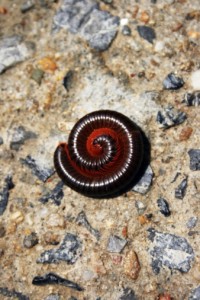 Millipedes normally live outdoors in damp places such as in mulch around outdoor plantings, and under decaying leaves. They feed on damp and decaying vegetable matter as well as new roots and green leaves. They also live in piles of leaf litter in wooded areas. In dry weather they will migrate out of litter piles as the leaves dry. They then can enter buildings or home in large numbers.
Millipedes normally live outdoors in damp places such as in mulch around outdoor plantings, and under decaying leaves. They feed on damp and decaying vegetable matter as well as new roots and green leaves. They also live in piles of leaf litter in wooded areas. In dry weather they will migrate out of litter piles as the leaves dry. They then can enter buildings or home in large numbers.
Millipedes or ” thousand leggers” as they are commonly known, are brownish, oval and elongate animals with two pairs of legs attached to most segments. They are 1 to 1 1/2 inches long and coil up when resting. They feed and reproduce in decaying organic matter. For complete treatment a thorough outdoor treatment is necessary along with removing plant mulch and leaves around the foundation of a building or home.


